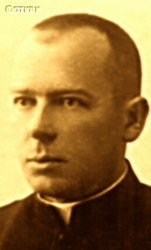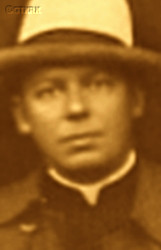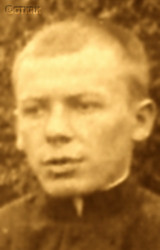Roman Catholic
St Sigismund parish
05-507 Słomczyn
85 Wiślana Str.
Konstancin deanery
Warsaw archdiocese, Poland
full list:
displayClick to display full list

searchClick to search full list by categories
wyświetlKliknij by wyświetlić pełną listę po polsku

szukajKliknij by przeszukać listę wg kategorii po polsku

Martyrology of the clergy — Poland
XX century (1914 – 1989)
personal data
surname
KUC
forename(s)
Michael Archangel (pl. Michał Archanioł)

function
diocesan priest
creed
Latin (Roman Catholic) Church RCmore on
en.wikipedia.org
[access: 2014.09.21]
diocese / province
Tarnów diocesemore on
en.wikipedia.org
[access: 2013.05.19]
RC Military Ordinariate of Polandmore on
en.wikipedia.org
[access: 2014.12.20]
honorary titles
Rochettum et Mantolettum canonmore on
Rochettum et Mantolettum canon
(20.12.1949)
Expositorii Canonicalis canonmore on
Expositorii Canonicalis canon
(24.12.1936)
date and place
of death
27.04.1951

Dąbrówka Polskatoday: neighborhood in Nowy Sącz, Nowy Sącz pov., Lesser Poland voiv., Poland
more on
en.wikipedia.org
[access: 2021.04.01]
details of death
On 01.01.1927, appointed reserve chaplain of the Polish Army in the rank of captain (for a statutory period of 2 years).
After the end of World War II hostilities, started with German and Russian invasion of Poland in 1939, after start of Russian occupation in 1945 for the first time arrested by the Commie‐Nazi unit of UB, branch of Russian KGB, for collaboration with Polish clandestine resistance in 1944.
Held in Nowy Sącz custody.
Released after a few months.
Arrested again by UB on 18.08.1948 for collaboration with clandestine resistance PPAN and WIN (successor fo clandestine Home Army AK, part of Polish Clandestine State during World War II) — was supposed to, i.a., lend money to partisans, today called „cursed/forgotten soldiers”, who did not agree to the Russian, Commie‐Nazi occupation of Poland.
Held in custody in Nowy Sącz, and then in the so‐called „St Michael's” prison (in the building of the former Baroque St Michael church), and finally prob. in the Montelupich Str. prison in Kraków where was tortured.
On 29.11.1949 in Kraków tried, pursuant to Art. 14 and Art. 18 par. 1, of the Commie‐Nazi decree of 13.06.1946 „on crimes particularly dangerous during the period of rebuilding the State”, known as the „Small Penal Code”, in force until 1970, which was a legal tool for persecution and murder of opponents of the Russian occupation in Poland.
Sentenced by the Commie‐Nazis to one year of suspended imprisonment.
By the decision of 29.11.1948 released.
Subsequently for a long time hospitalised in Nowy Sącz.
Perished without recovering, exhausted, from suffering from tuberculosis.
cause of death
exhaustion
perpetrators
Russians / Poles
sites and events
Cracow (Montelupich)Click to display the description, Nowy SączClick to display the description, GeneralgouvernementClick to display the description, Ribbentrop‐MolotovClick to display the description, Pius XI's encyclicalsClick to display the description
date and place
of birth
04.09.1890Birth certification on:
skanoteka.genealodzy.pl
[access: 2025.08.19]

Jasna Podłopieńtoday: Podłopień, Tymbark gm., Limanowa pov., Lesser Poland voiv., Poland
more on
en.wikipedia.org
[access: 2021.04.01]
parents
KUC John
🞲 ?, ? — 🕆 ?, ?

MUCHA Regina
🞲 ?, ? — 🕆 ?, ?
baptism
07.09.1890Birth certification on:
skanoteka.genealodzy.pl
[access: 2025.08.19]

Tymbarktoday: Tymbark gm., Limanowa pov., Lesser Poland voiv., Poland
more on
en.wikipedia.org
[access: 2021.04.01]
Nativity of the Blessed Virgin Mary RC churchmore on
pl.wikipedia.org
[access: 2021.12.19]
presbyter (holy orders)
ordination
29.06.1916

Tarnówtoday: Tarnów city pov., Lesser Poland voiv., Poland
more on
en.wikipedia.org
[access: 2021.06.07]
Nativity of the Blessed Virgin Mary RC cathedral churchmore on
en.wikipedia.org
[access: 2025.03.14]
positions held
1950 – 1951
curatus/rector/expositus — Dąbrówka Polskatoday: neighborhood in Nowy Sącz, Nowy Sącz pov., Lesser Poland voiv., Poland
more on
en.wikipedia.org
[access: 2021.04.01] ⋄ St Rock RC church ⋄ Nowy Sącztoday: Nowy Sącz pov., Lesser Poland voiv., Poland
more on
en.wikipedia.org
[access: 2021.04.01], St Margaret the Virgin and Martyr RC parish ⋄ Nowy Sącztoday: Nowy Sącz pov., Lesser Poland voiv., Poland
more on
en.wikipedia.org
[access: 2021.04.01] RC deanery — retired
01.09.1923 – 1949
prefect — Nowy Sącztoday: Nowy Sącz pov., Lesser Poland voiv., Poland
more on
en.wikipedia.org
[access: 2021.04.01] ⋄ St Margaret the Virgin and Martyr RC parish ⋄ Nowy Sącztoday: Nowy Sącz pov., Lesser Poland voiv., Poland
more on
en.wikipedia.org
[access: 2021.04.01] RC deanery — e.g. at the Tadeusz Kościuszko Elementary School in the village of Dąbrówka Polska (today a housing estate in Nowy Sącz); from the 1930s resident in Dąbrówka Polska; from 1923 caretaker and restorer of the wooden church of St Roch; builder of the rectory in Dąbrówka Polska
01.05.1917 – 1923
vicar — Nowy Sącztoday: Nowy Sącz pov., Lesser Poland voiv., Poland
more on
en.wikipedia.org
[access: 2021.04.01] ⋄ St Margaret the Virgin and Martyr RC parish ⋄ Nowy Sącztoday: Nowy Sącz pov., Lesser Poland voiv., Poland
more on
en.wikipedia.org
[access: 2021.04.01] RC deanery
01.08.1916 – 1917
vicar — Chełmtoday: Bochnia gm., Bochnia pov., Lesser Poland voiv., Poland
more on
en.wikipedia.org
[access: 2021.04.01] ⋄ Nativity of St John the Baptist RC parish ⋄ Bochniatoday: Bochnia urban gm., Bochnia pov., Lesser Poland voiv., Poland
more on
en.wikipedia.org
[access: 2021.04.01] RC deanery
1911 – 1916
student — Tarnówtoday: Tarnów city pov., Lesser Poland voiv., Poland
more on
en.wikipedia.org
[access: 2021.06.07] ⋄ philosophy and theology, Theological Seminary
others related
in death
KUCClick to display biography Edward Casimir
sites and events
descriptions
Cracow (Montelupich): Cracow penal prison, during occupation run by the Germans — from 28.02.1941 by Germ. Geheime Staatspolizei (Eng. Secret State Police, known as Gestapo. In 1940‐1944 Germans jailed there approx. 50,000 prisoners, mainly Poles and Jews. Some of them were transported to KL Auschwitz concentration camp, some were executed. After cease in war effort the prison was used by UB — a Polish unit of Russian NKVD — as a prison for Polish independence resistance fighters, some of which were subsequently sent to prisons and slave labour camps in Russia. (more on: en.wikipedia.orgClick to attempt to display webpage
[access: 2014.10.31])
Nowy Sącz: Penal prison run by the Germans. In 1939‐1945 it was also an execution site, mainly Poles arrested by the Germans. After end of warfare used by Commie‐Nazi UB, Polish branch of Russian KGB, to hold „forgotten soldiers” who continued to fight against Russian occupation after 1945. (more on: www.sw.gov.plClick to attempt to display webpage
[access: 2013.08.17])
Generalgouvernement: After the Polish defeat in the 09.1939 campaign, which was the result of the Ribbentrop‐Molotov Pact and constituted the first stage of World War II, and the beginning of German occupation in part of Poland (in the other, eastern part of Poland, the Russian occupation began), the Germans divided the occupied Polish territory into five main regions. In two of them new German provinces were created, two other were incorporated into other provinces. However, the fifth part was treated separately, and in a political sense it was supposed to recreate the German idea from 1915 (during World War I, after the defeat of the Russians in the Battle of Gorlice in 05.1915) of creating a Polish enclave within Germany. Illegal in the sense of international law, i.e. Hague Convention, and public law, managed by the Germans according to separate laws — especially established for the Polish Germ. Untermenschen (Eng. subhumans) — till the Russian offensive in 1945 it constituted part of the Germ. Großdeutschland (Eng. Greater Germany). Till 31.07.1940 formally called Germ. Generalgouvernement für die besetzten polnischen Gebiete (Eng. General Government for the occupied Polish lands) — later simply Germ. Generalgouvernement (Eng. General Governorate), as in the years 1915‐1918. From 07.1941, i.e. after the German attack on 22.06.1941 against the erstwhile ally, the Russians, it also included the Galicia district, i.e. the Polish pre‐war south‐eastern voivodeships. A special criminal law was enacted and applied to Poles and Jews, allowing for the arbitrary administration of the death penalty regardless of the age of the „perpetrator”, and sanctioning the use of collective responsibility. After the end of the military conflict of the World War UU, the government of the Germ. Generalgouvernement was recognized as a criminal organization, and its leader, governor Hans Frank, guilty of war crimes and crimes against humanity and executed. (more on: en.wikipedia.orgClick to attempt to display webpage
[access: 2024.12.13])
Ribbentrop‐Molotov: Genocidal Russian‐German alliance pact between Russian leader Joseph Stalin and German leader Adolf Hitler signed on 23.08.1939 in Moscow by respective foreign ministers, Mr. Vyacheslav Molotov for Russia and Joachim von Ribbentrop for Germany. The pact sanctioned and was the direct cause of joint Russian and German invasion of Poland and the outbreak of the World War II in 09.1939. In a political sense, the pact was an attempt to restore the status quo ante before 1914, with one exception, namely the „commercial” exchange of the so‐called „Kingdom of Poland”, which in 1914 was part of the Russian Empire, fore Eastern Galicia (today's western Ukraine), in 1914 belonging to the Austro‐Hungarian Empire. Galicia, including Lviv, was to be taken over by the Russians, the „Kingdom of Poland” — under the name of the General Governorate — Germany. The resultant „war was one of the greatest calamities and dramas of humanity in history, for two atheistic and anti‐Christian ideologies — national and international socialism — rejected God and His fifth Decalogue commandment: Thou shall not kill!” (Abp Stanislav Gądecki, 01.09.2019). The decisions taken — backed up by the betrayal of the formal allies of Poland, France and Germany, which on 12.09.1939, at a joint conference in Abbeville, decided not to provide aid to attacked Poland and not to take military action against Germany (a clear breach of treaty obligations with Poland) — were on 28.09.1939 slightly altered and made more precise when a treaty on „German‐Russian boundaries and friendship” was agreed by the same murderous signatories. One of its findings was establishment of spheres of influence in Central and Eastern Europe and in consequence IV partition of Poland. In one of its secret annexes agreed, that: „the Signatories will not tolerate on its respective territories any Polish propaganda that affects the territory of the other Side. On their respective territories they will suppress all such propaganda and inform each other of the measures taken to accomplish it”. The agreements resulted in a series of meeting between two genocidal organization representing both sides — German Gestapo and Russian NKVD when coordination of efforts to exterminate Polish intelligentsia and Polish leading classes (in Germany called «Intelligenzaktion», in Russia took the form of Katyń massacres) where discussed. Resulted in deaths of hundreds of thousands of Polish intelligentsia, including thousands of priests presented here, and tens of millions of ordinary people,. The results of this Russian‐German pact lasted till 1989 and are still in evidence even today. (more on: en.wikipedia.orgClick to attempt to display webpage
[access: 2015.09.30])
Pius XI's encyclicals: Facing the creation of two totalitarian systems in Europe, which seemed to compete with each other, though there were more similarities than contradictions between them, Pope Pius XI issued in 03.1937 (within 5 days) two encyclicals. In the „Mit brennender Sorge” (Eng. „With Burning Concern”) published on 14.03.1938, condemned the national socialism prevailing in Germany. The Pope wrote: „Whoever, following the old Germanic‐pre‐Christian beliefs, puts various impersonal fate in the place of a personal God, denies the wisdom of God and Providence […], whoever exalts earthly values: race or nation, or state, or state system, representatives of state power or other fundamental values of human society, […] and makes them the highest standard of all values, including religious ones, and idolizes them, this one […] is far from true faith in God and from a worldview corresponding to such faith”. On 19.03.1937, published „Divini Redemptoris” (Eng. „Divine Redeemer”), in which criticized Russian communism, dialectical materialism and the class struggle theory. The Pope wrote: „Communism deprives man of freedom, and therefore the spiritual basis of all life norms. It deprives the human person of all his dignity and any moral support with which he could resist the onslaught of blind passions […] This is the new gospel that Bolshevik and godless communism preaches as a message of salvation and redemption of humanity”… Pius XI demanded that the established human law be subjected to the natural law of God , recommended the implementation of the ideal of a Christian state and society, and called on Catholics to resist. Two years later, National Socialist Germany and Communist Russia came together and started World War II. (more on: www.vatican.vaClick to attempt to display webpage
[access: 2023.05.28], www.vatican.vaClick to attempt to display webpage
[access: 2023.05.28])
sources
personal:
www.tymbark.tarnow.opoka.org.plClick to attempt to display webpage
[access: 2013.05.19], www.aposteriori.org.plClick to attempt to display webpage
[access: 2013.05.19], www.sbc.nowysacz.plClick to attempt to display webpage
[access: 2016.11.06], skanoteka.genealodzy.plClick to attempt to display webpage
[access: 2025.08.19], www.limanowa.inClick to attempt to display webpage
[access: 2013.05.19], limanowa.inClick to attempt to display webpage
[access: 2025.08.19]
original images:
www.sbc.nowysacz.plClick to attempt to display webpage
[access: 2015.09.30], www.sbc.nowysacz.plClick to attempt to display webpage
[access: 2015.09.30], www.sbc.nowysacz.plClick to attempt to display webpage
[access: 2015.09.30]
LETTER to CUSTODIAN/ADMINISTRATOR
If you have an Email client on your communicator/computer — such as Mozilla Thunderbird, Windows Mail or Microsoft Outlook, described at WikipediaPatrz:
en.wikipedia.org, among others — try the link below, please:
LETTER to CUSTODIAN/ADMINISTRATORClick and try to call your own Email client
If however you do not run such a client or the above link is not active please send an email to the Custodian/Administrator using your account — in your customary email/correspondence engine — at the following address:

giving the following as the subject:
MARTYROLOGY: KUC Michael Archangel
To return to the biography press below:
 Click to return to biography
Click to return to biography











